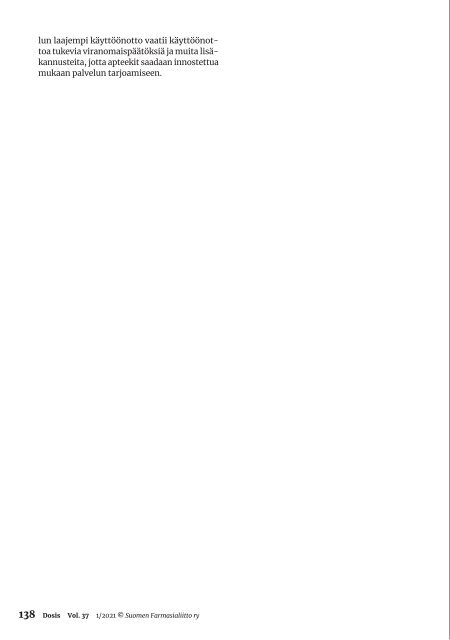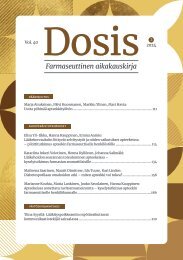DOSIS 1/2021
Farmaseuttinen aikakauskirja DOSIS 1/2021 vol.37 5uomen Farmasialiitto ry
Farmaseuttinen aikakauskirja DOSIS 1/2021 vol.37 5uomen Farmasialiitto ry
You also want an ePaper? Increase the reach of your titles
YUMPU automatically turns print PDFs into web optimized ePapers that Google loves.
lun laajempi käyttöönotto vaatii käyttöönottoa<br />
tukevia viranomaispäätöksiä ja muita lisäkannusteita,<br />
jotta apteekit saadaan innostettua<br />
mukaan palvelun tarjoamiseen.<br />
Summary<br />
Pilot study: The current medication<br />
safety status of automated dose<br />
dispensing process in homecare and<br />
it's development with the help of<br />
community pharmacy's risk<br />
management tool<br />
Mari Kuuttila*<br />
MSc (Pharm.), Specialist in management,<br />
Specialist trainee in Community<br />
and Hospital Pharmacy<br />
University of Helsinki<br />
mari.kuuttila@ahs.ax<br />
Niina Laine<br />
PhD (Pharm), Master in clinical pharmacy<br />
Aino and Eino Medicationservices<br />
Leena Astala<br />
MSc (Pharm.),<br />
Owner of Porin Asema-apteekki<br />
* Correspondence<br />
Introduction<br />
The pharmacy's automated dose dispensing<br />
service is expected to improve the quality<br />
and safety of medication and to decrease<br />
drug delivery errors. The medication safety of<br />
the home care dose dispensing process can be<br />
improved by identifying the risks of the process.<br />
With the help of the new Safe Pharmacotherapy<br />
Support service developed by the Finnish<br />
Pharmacy Association,<br />
pharmacies can work in multi-professional<br />
co-operation to improve the medication safety<br />
of home care and service housing units. With<br />
the Safe automated dose dispensing management<br />
tool, risks related to the dose dispensing<br />
process can be identified.<br />
The aim of the pilot study was to describe<br />
the current state and development of the medication<br />
safety of the automated dose dispensing<br />
process in home care with the help of a community<br />
pharmacy`s risk management tool. In<br />
addition, the aim was to describe the views of<br />
the nursing staff on the impact of the tool on<br />
the medication safety of the dose distribution<br />
process and how the cooperation between the<br />
pharmacy and the units developed.<br />
Materials and methods<br />
The pilot study was carried out between 20st<br />
April 2019 and 31st May 2020. The research<br />
coverletters were piloted before the study was<br />
published. The request to participate in the<br />
pilot study was sent to the pharmacists of the<br />
member pharmacies of the Finnish Pharmacy<br />
Association (n = 632) by e-mail. The research<br />
material was collected using risk management<br />
tools and monitoring and feedback forms. The<br />
material was analyzed by qualitative materialbased,<br />
descriptive content analysis.<br />
Results<br />
The study involved six pharmacies and home<br />
care units, including the pilot. Based on the risk<br />
management tools, the written instructions for<br />
the home care dose distribution process and<br />
the identification of its risks were incomplete,<br />
and the cooperation between the pharmacy and<br />
home care was limited after the start of dose<br />
distribution. Each home care unit set four to six<br />
goals for development. The most common were<br />
making a dose distribution policy, updating the<br />
medication management plan, and initiating<br />
annual dose distribution meetings between the<br />
community pharmacy and home care. After the<br />
follow-up period, some of the development<br />
projects had been completed, some were in<br />
progress or suspended. The staff of the units<br />
found the tool and interprofessional cooperation<br />
useful, and to be able to improve the dose<br />
dispensing processes medication safety.<br />
Conclusions<br />
With the help of risk management tools, it<br />
was possible to form an image of the risk factors<br />
for the safety of medication in the automated<br />
dose distribution process in home care<br />
and what kind of concrete development targets<br />
were needed. From the follow-up and feedback<br />
forms, it was possible to find out the staff's<br />
views on the impact of the cooperation on the<br />
dispensing processes medication safety, as well<br />
138 Dosis Vol. 37 1/<strong>2021</strong> © Suomen Farmasialiitto ry Suomen Farmasialiitto ry © 1/<strong>2021</strong> Vol. 37 Dosis 139

















